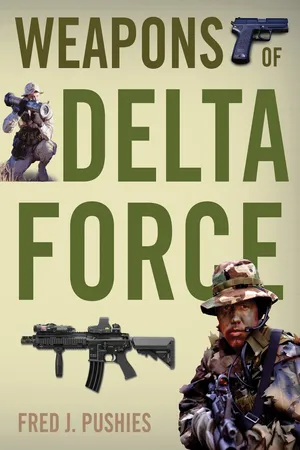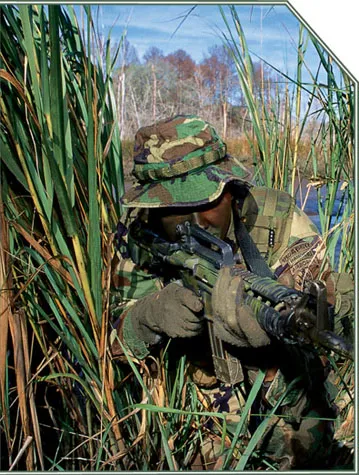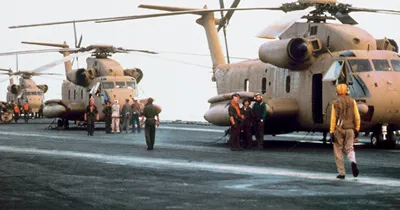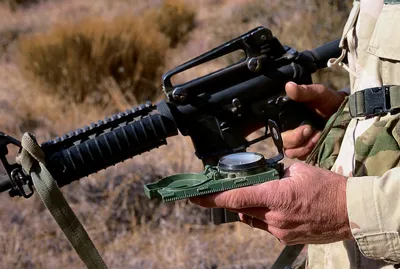
- 128 pages
- English
- ePUB (mobile friendly)
- Available on iOS & Android
eBook - ePub
Weapons of Delta Force
About this book
America's elite counterterrorist organization, Delta Force, is a handpicked group of the U.S. Army's finest soldiers. The group specializes in hostage rescues and other difficult procedures to protect the lives of Americans throughout the world. Delta uses some of the most sophisticated weapons in the field today, and all are detailed in this book. Pistols, sniper rifles, special mission aircraft, fast attack vehicles, SCUBA and paratrooper gear, and more are presented in this fully illustrated account of our country's heroes and their tools of the trade.
Frequently asked questions
Yes, you can cancel anytime from the Subscription tab in your account settings on the Perlego website. Your subscription will stay active until the end of your current billing period. Learn how to cancel your subscription.
At the moment all of our mobile-responsive ePub books are available to download via the app. Most of our PDFs are also available to download and we're working on making the final remaining ones downloadable now. Learn more here.
Perlego offers two plans: Essential and Complete
- Essential is ideal for learners and professionals who enjoy exploring a wide range of subjects. Access the Essential Library with 800,000+ trusted titles and best-sellers across business, personal growth, and the humanities. Includes unlimited reading time and Standard Read Aloud voice.
- Complete: Perfect for advanced learners and researchers needing full, unrestricted access. Unlock 1.4M+ books across hundreds of subjects, including academic and specialized titles. The Complete Plan also includes advanced features like Premium Read Aloud and Research Assistant.
We are an online textbook subscription service, where you can get access to an entire online library for less than the price of a single book per month. With over 1 million books across 1000+ topics, we’ve got you covered! Learn more here.
Look out for the read-aloud symbol on your next book to see if you can listen to it. The read-aloud tool reads text aloud for you, highlighting the text as it is being read. You can pause it, speed it up and slow it down. Learn more here.
Yes! You can use the Perlego app on both iOS or Android devices to read anytime, anywhere — even offline. Perfect for commutes or when you’re on the go.
Please note we cannot support devices running on iOS 13 and Android 7 or earlier. Learn more about using the app.
Please note we cannot support devices running on iOS 13 and Android 7 or earlier. Learn more about using the app.
Yes, you can access Weapons of Delta Force by Fred Pushies in PDF and/or ePUB format, as well as other popular books in History & Military & Maritime History. We have over one million books available in our catalogue for you to explore.
Information

The best of the best! As in the beginning, over two decades ago, Delta Force still draws many of its operators from the ranks of the U.S. Army Special Forces—“The Green Berets.” Experts in Direct Action (DA), Special Reconnaissance (SR), Counterterrorism (CT), and Foreign Internal Defense (FID), they are the perfect pool from which to draw. These highly skilled and motivated individuals bring a valuable asset to the Delta organization.
Operation Eagle Claw
In November 1979 a group of Iranian “students” captured the U.S. embassy in Teheran, Iran. The Air Force rushed to regenerate its special operations capabilities. By December 1979 a rescue force was chosen and training commenced. Training exercises were conducted through March 1980 and on 16 April 1980, the Joint Chiefs of Staff (JCS) approved the mission. On 19 April, the rescue forces, consisting of Army, Navy, Air Force, and Marine assets, began to deploy to Southwest Asia. Delta Force would be tasked with the assault on the embassy and the rescue of the American hostages.

Two RH-53D helicopters are brought up to the deck in preparation for Operation Eagle Claw. While appearing as a military debacle, the operation would prove to be a watershed for U.S. Special Operation Forces, and Delta in particular. Defense Visual Information Center
On 24 April, after six months of failed negotiations, the National Command Authorities (NCA) ordered the execution of Operation Eagle Claw to free U.S. hostages held in Iran. Under the cover of darkness, eight RH-53D helicopters departed the USS Nimitz on station in the Arabian Sea; at the same time six C-130s left Masirah Island, Oman. Both sets of aircraft set off for a prearranged site 600 miles into the desert wasteland, code designation Desert One. The Achilles’ heels in the operation were the helicopters. A few hours into the mission, two helicopters had aborted due to mechanical failure. A desert dust storm, known as a “Haboob” caused the remaining helicopters to arrive late; and yet another suffered a hydraulic leak that its crew determined to be unfixable at the Desert One site. This determination resulted in only five operational helicopters. Mission planners had ascertained a minimum of six helicopters were required for the mission to continue, now with only five available, the mission had to be aborted.
With the decision to abort, it was time to load up the aircraft and “get out of Dodge.” While repositioning his RH-53D helicopter for refueling, one of the pilots collided with a C-130. This resulted in the two aircraft rapidly being engulfed in flames. With the situation hastily moving from bad to worse to disastrous, the on-scene commander, Col. Charlie Beckwith, decided to load all the survivors—remaining troops, assault team, and Marine air crews on the C-130—and depart Desert One ASAP! Eight men had been killed and five more injured. They left behind five intact helicopters, the burned wreckage of the helicopter and C-130, and the dead. Operation Eagle Claw had failed. This had cost the lives of eight gallant troops; it would cost the honor of the United States of America, and it would cost the credibility of U.S. Special Operations.
Many books and articles have been written describing the mission in detail, so we will not belabor the operation here. Very simply stated: The plan was to assemble eight Navy RH-53D helicopters at Desert One. Under the cover of darkness, the helicopters would be refueled from KC-130 tankers, which would also land in the desert, load a 120-man Army assault team and proceed to two additional hide sites. The Delta assault team would proceed to the U.S. embassy, extract the hostages, rendezvous with the helicopters, and be extracted from the city. In actuality, the Delta operators never got to carry out their mission, the rescue of the hostages.
Following the disaster at Desert One, a review committee, known as the Holloway Commission, chaired by Adm. James L. Holloway III, including Gen. LeRoy Manor, who commanded the Son Tay raid into North Vietnam, convened to look into problems within U.S. Special Operations. The outcome of this commission resulted in two major recommendations. First, the Department of Defense (DOD) should establish a Counter Terrorism Joint Task Force (CTJTF) as a field organization of the Joint Chiefs of Staff with a permanently assigned staff and forces. The JCS would plan, train for, and conduct operations to counter terrorist activities directed against the United States. The CTJTF would utilize military forces in the counter terrorism (CT) role.

RH-53D helicopters prepare for departure from the USS Nimitz, their destination a clandestine location in the Iranian desert, code designation Desert One. On 24 April, Operation Eagle Claw, the mission to free U.S. hostages held in Iran, had commenced. The mission, which began as a courageous attempt, ended in disaster. Defense Visual Information Center
These forces could range in size from small units of highly specialized personnel to larger integrated forces. Second, the JCS should consider the formation of a Special Operations Advisory Panel (SOAP). This panel would consist of high-ranking officers to be drawn from both active service and retired personnel. The prerequisite for selection was a background in special operations or having served at a Commander in Chief (C in C) or JCS level and having maintained a proficient level of interest in special operations or defense policy.
One issue raised by the commission concerned the selection of helicopter air crews. Were the pilots up to the task? Why had they selected the Marines when more than 100 qualified Air Force H-53 pilots were available? If we look at today’s standards, the Marine pilots had big boots to fill. They were being asked to fly at night; this alone was unusual practice for the “flying leathernecks.” These pilots were now being asked to perform the extraordinary. Launch off the deck of a carrier, at night; fly (NOE) where radar could not detect them and with no running lights. The pilots were issued PVS5 night-vision goggles; however, they could only be worn at 30-minute intervals. This meant the pilot and co-pilot had to alternate flying the huge helicopter every 30 minutes. The Marines had no pilots that had been trained in this type of flying. In fact, none of the services were prepared for such a contingency.
Regarding the helicopters: The commission concluded that a minimum of 10 to 12 helicopters should have been deployed. This redundancy in air assets would have secured a higher probability of success should problems have arisen, resulting in a minimum of six operational helicopters at Desert One, which was the minimum requirement for the completion of the mission. This legacy may prove to hamper future special operations. It is this commission’s direction that spawned interest in the V-22 Osprey, redesignated the MV-22 and CV-22 for use among Marine and Special Operations Forces (SOF). Many Osprey evangelists believe that the Osprey will aspire to a principal SOF air asset and infiltration/exfiltration (Infil/Exfil) platform. The only problem is, the dang thing won’t seem to stay in the air and has already cost the lives of more than 20 troops. Oh—and you can not seem to fit any type of ground-support vehicle in the Special Ops (or entire U.S. Military) inventory inside: no Fast Attack Vehicles (FAV), no HUMMVs, not even the AFSOC, or Rapid All Terrain Transport (RATT), can be deployed inside the aircraft. However, you can fit six of them on the deck of an aircraft carrier. Time will tell whether the Osprey will have a place in the Special Ops inventory, or end up hanging in the U.S. Air Force Museum in Dayton, Ohio.
Another issue was the lack of a thorough readiness assessment and schedule of mission rehearsals. From the onset, training was not conducted in a truly joint method. Due to security and logistical considerations, the training was compartmentalized and held at scattered locations across the continental United States, as well as abroad. The limited rehearsals conducted could only evaluate various segments of the entire mission. Additionally, preparation was carried out at the individual and unit level within each element.
There was no designated mission commander for six months, breaching the principle of unity of command. This lack of command and control hampered the training, planning, and execution of the operation. There were separate commanders for site security, ground force, landing support, KC-130s, and the helicopter force. Compounding the problem were procedural limitations and lack of communications interoperability.
While the mission itself ended in disaster, you can truly not cast blame on Delta. In reality, members of the force did not get up to bat, so while they did not hit a home run, neither did they strike out. Indeed, Desert One would serve as a catalyst for the evolution of the U.S. Special Operations Forces, and a foundation upon which Delta Force would rise up to become the formidable force it is today.
USSOCOM
Over two decades have passed since the Desert One initiative. Today, America Special Operation Forces are par excellence and second to none. There is no greater light infantry unit in the world than the U.S. Army Rangers. The U.S. Army Special Forces—“The Green Berets”—are deployed in numerous countries of the free world, and some not so free. The activities of the U.S. Navy SEALs are legendary. The air assets of the 160th Special Operations Aviation Regiment (Airborne) (SOAR(A)) and Air Force Special Operations Command (AFSOC) are equipped with the latest technology, and the pilots/air crews are the best in the world.
Overseeing all of the U.S. Special Operations Forces is the U.S. Special Operations Command (USSOCOM), located at McDill Air Force Base in Tampa, Florida. Each of the three services, Army, Air Force, and Navy, has a subordinate command to SOCOM. An additional subordinate command under SOCOM is the Joint Special Operations Command, (JSOC). According to the United States Special Operations Forces Posture Statement, JSOC “is a joint headquarters designed to study special operations requirements and techniques, ensure interoper-ability and equipment standardization, plan and conduct special operations exercises and training; and develop joint special operations tactics.” Activated in 1981 at Fort Bragg, North Carolina, JSOC’s mission was to consolidate control of, and help develop special operations doctrine for, training, deployment, and other CT missions. Since that time its mission has expanded to encompass direct action (DA) missions, which require unique skills of its operators. It has also relocated to Pope Air Force Base, next door to Fort Bragg, just south of Green Ramp.

Delta Force routinely holds open recruitment twice a year. While any Army MOS (Military Occupational Specialty) may apply for selection into Delta, a high percentage of those selected come from the Ranger battalions. The U.S. Army Rangers are a natural progression in the Special Operations Forces. It is not unusual to see the Ranger tab just under the Special Forces Qualification tab worn by many of the Delta operators.
Delta Force is officially designated as the 1st Special Forces Operational Detachment—DELTA. The unit also has a cover name and is known as the Combat Applications Group, or CAG. The official comments from SOCOM on CAG states, “Effective 1 October 1991, the U.S. Army Combat Applications Group (Airborne) was activated as a subordinate element of the U.S. Army Special Operations Command (USASOC). Formed during the restructuring of Army special operations assets, the CAG (Abn) tests special operations methods, equipment, tactics, and combined arms interoperability with a focus of the development of doctrine beyond the year 2000.”
Delta Force has also evolved over the years into a force to be reckoned with. Delta was organized in the late 1970s under the command of Col. “Chargin’ Charlie” Beckwith. The unit was headquartered in the Fort Bragg Stockade building. It even could trace its lineage to the Office of Strategic Service (OSS) of World War II, as some of the evaluation tests given to OSS agents are also required during the selection process of Delta candidates. The many lessons Col. Beckwith learned during his exchange with the British SAS set the standards for the troops then as well as for future operators.
Today’s Delta has moved from the stockade and has relocated to a more remote site at Fort Bragg. The Delta operators come from a mature military background, all NCOs and captains, minimum. The Force attracts most of its recruits from the ranks of the Rangers and Special Forces (SF), although others are considered according to the need of the unit. Having such outstanding individuals to draw upon, Delta is undisputedly the cream of the crop.

Land navigation is indispensable to a Delta operator. During the selection process, candidates will undergo numerous exercises to instill and hone this proficiency. Delta operators are experts at using a map and a compass, as well as celestial navigation, that is using the stars. Although they are issued GPS units and are quite adept in their use, they must always be able to travel from point to point relying on traditional alternatives.
While Delta maintains a high level of secrecy, it does offer open recruitment from time to time. Delta will travel to various military installations to seek individuals who may have what it takes and possess the needed skills to become a member of the unit. Part of the orientation at the Special Forces Non Commissioned Officers Academy includes a presentation from the Delta recruiter.
Although the Department of Defense categorically states that any reference to Delta Force is completely classified, it makes no secret as to the recruitment of its members. Delta conducts worldwide recruitment campaigns twice each year just prior to its spring and fall Asses-sment-and-Selection Course. Due to the very nature of the Force, and the missions performed, Delta operators are carefully screened, evaluated, selected, and trained. The assessment process evaluates whether the candidate possesses the necessary stamina, dedication, and self-discipline to perform the unique and arduous tasks required of Delta members—while simultaneously enduring physical and psychological stress. Both officers and NCOs undergo the identical assessment, selection, and training.
The general prerequisites for officers and NCOs are the following: volunteer; Army active duty, Reserve, or National Guard; male; U.S. citizen; passing a HALO/SCUBA physical and eye examination; no limiting physical profile; airborne-qualified or volunteer for airborne training; passing a background security investigation and having a minimum clearance of SECRET; minimum age of 22; no history of recurring disciplinary action; passing the five-event physical-fitness qualification test (inverted crawl; run, dodge, and jump; pushups; situps; two-mile run; and 100-meter swim—all while wearing BDU and boots).
NCO prerequisites: rank of sergeant (E-5) through sergeant first class (E-7), four years minimum time in service, passing SQT score in primary Military Occupational Specialty (MOS), minimum GT score of 110, two years active service remaining upon selection.
Officer prerequisites: captain or major (branch immaterial); advanced-course graduate; college graduate (B.A. or B.S.); minimum of 12 months successful command (company, battery, troop, Special Force A-detachment, or aviation platoon).
Assessment and Selection is completed in three to four weeks and is divided into three phases. During this time the candidate will endure numerous physical-fitness exercises, including an 18-mile “ruck march” carrying 40 to 45 pounds in his rucksack. This is a timed march and must be completed within four and a half hours or less. The next phase is advanced land navigation. This brings all the individuals up to speed and prepares them for the third phase. Even in this modern age of GPS, the candidate must be proficient with a map and compass; it is mandatory for each candidate to master these skills. Finally, Phase III, which mirrors many of the tasks the British SAS carry out, as its recruits shoulder a Bergen and traverse the Brecon Beacons in Wales. In this test of endurance and mental stamina, the ind...
Table of contents
- Cover
- Title Page
- Dedication
- Contents
- Acknowledgments
- Introduction
- Chapter 1 History and Background
- Chapter 2 M4A1 Carbine
- Chapter 3 HK Submachine Guns and Pistols
- Chapter 4 The Armory
- Chapter 5 Tactical Gear
- Chapter 6 Techniques
- Chapter 7 Support Elements
- Glossary
- Abbreviations & Acronyms
- Index
- Copyright Page